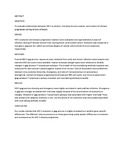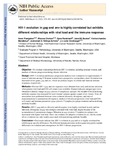| dc.contributor.author | Piantadosi, A | |
| dc.contributor.author | Chohan, B | |
| dc.contributor.author | Panteleeff, D | |
| dc.contributor.author | Baeten, JM | |
| dc.contributor.author | Mandaliya, K | |
| dc.contributor.author | Ndinya-Achola JO. | |
| dc.contributor.author | Overbaugh, J | |
| dc.date.accessioned | 2013-04-24T10:08:52Z | |
| dc.date.available | 2013-04-24T10:08:52Z | |
| dc.date.issued | 2009 | |
| dc.identifier.citation | AIDS. 2009 Mar 13;23(5):579-87 | en |
| dc.identifier.uri | http://www.ncbi.nlm.nih.gov/pubmed/19516110 | |
| dc.identifier.uri | http://erepository.uonbi.ac.ke:8080/xmlui/handle/123456789/16566 | |
| dc.description.abstract | OBJECTIVE:
To evaluate relationships between HIV-1 evolution, including immune evasion, and markers of disease progression during chronic infection.
DESIGN:
HIV-1 evolution and disease progression markers were evaluated over approximately 5 years of infection among 37 Kenyan women from a prospective, seroincident cohort. Evolution was measured in two genes, gag and env, which are primary targets of cellular and humoral immune responses, respectively.
METHODS:
Proviral HIV-1 gag and env sequences were obtained from early and chronic infection when plasma viral load and CD4 cell counts were available. Human leukocyte antigen types were obtained to identify changes in gag cytotoxic T-lymphocyte epitopes. The breadth of the neutralizing antibody response was measured for each woman's plasma against a panel of six viruses. Tests of association were performed between virus evolution (diversity, divergence, and ratio of nonsynonymous to synonymous divergence), markers of disease progression (viral load and CD4 cell count), and immune parameters (gag cytotoxic T lymphocyte epitope mutation and neutralizing antibody breadth).
RESULTS:
HIV-1 gag and env diversity and divergence were highly correlated in early and late infection. Divergence in gag was strongly correlated with viral load, largely because of the accumulation of synonymous changes. Mutation in gag cytotoxic T-lymphocyte epitopes was associated with higher viral load. There was evidence for adaptive evolution in env, but the extent of env evolution was only weakly associated with neutralizing antibody breadth.
CONCLUSION:
Our results indicate that HIV-1 evolution in gag and env is highly correlated but exhibits gene-specific differences. The different immune pressures on these genes may partly explain differences in evolution and consequences for HIV-1 disease progression. | en |
| dc.language.iso | en | en |
| dc.title | HIV-1 evolution in gag and env is highly correlated but exhibits different relationships with viral load and the immune response | en |
| dc.type | Article | en |
| local.publisher | Division of Human Biology, Fred Hutchinson Cancer Research Center, Seattle, Washington 98109-1024, USA | en |
| local.publisher | Department of Medical Microbiology, University of Nairobi | en |


